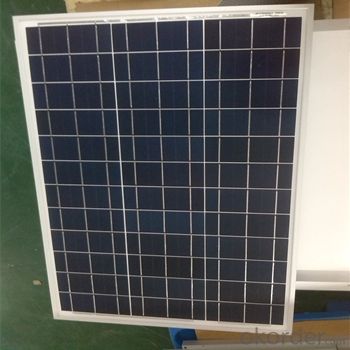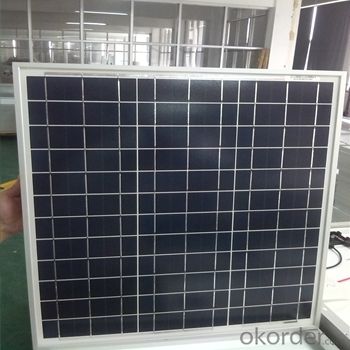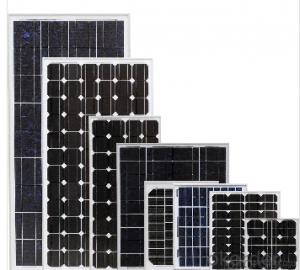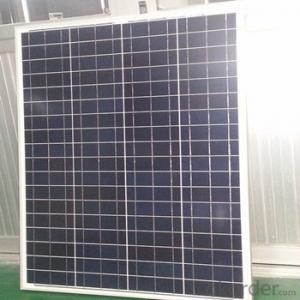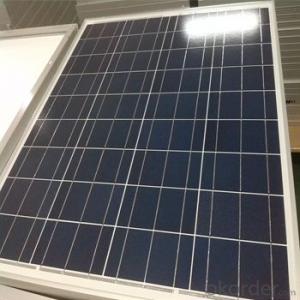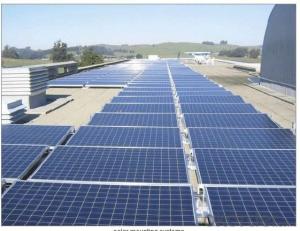Campervan Solar Panels - 60W Polycrystalline Solar Module CNBM Series
- Loading Port:
- Shanghai
- Payment Terms:
- TT OR LC
- Min Order Qty:
- 25 pc
- Supply Capability:
- 20000 pc/month
OKorder Service Pledge
OKorder Financial Service
You Might Also Like
Polycrystalline Solar Module-60w CNBM Series
High efficiency crystalline solar cell. Even if under the weak light, the solar module can produce maximum power output.
II Tempered glass (toughened glass): Anti-reflecting coating and high transmission rate glass increase the power output and mechanical strength of solar module.
III EVA and TPT: Using high quality EVA and TPT to prevent destroying and water.
IV AI frame: Without screw, rner connection. 6 holes on the frame can be installed easily.
V Junction box: Multi function junction box with water proof.
VI Long lifetime: ≥25 years; Less power decrease.
VII Good performance of preventing from atrocious weather such as wind and hails.
VIII Resisting moisture and etching effectively, not effected by geology.
IX The certificate issued by international authority: UL, TUV, IEC, CE.
Standard Test Conditions of Polycrystalline Silicon Solar Panel
The opto-electrical specifications shown below are stabilized values being measured at Standard Test Conditions, Irradiance: 1000W/m2, Spectrum: AM1.5 at 25°C, The info below is subject to manufacturing tolerances. Where appropriate minutes of measurement are available and are used for the dimensioning of the installation.
Advantages of Monocrystalline Silicon Solar Panel
• CNBM Solar performance guarantees for 25 years
• 12 years guarantee for workmanship
• Timeliness of delivery
• Quality Products certified (TÜV, UL, CE, ISO)
Specification
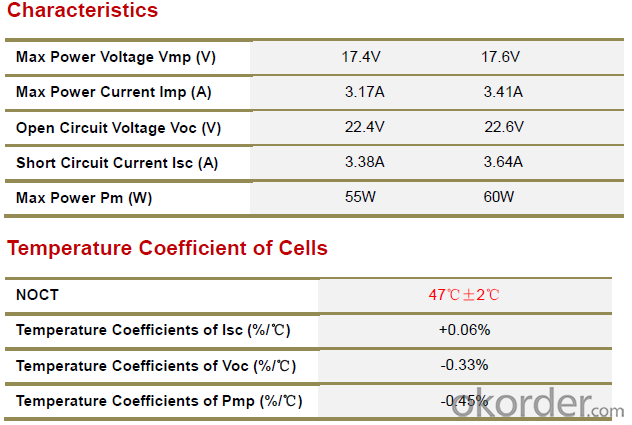

Certification
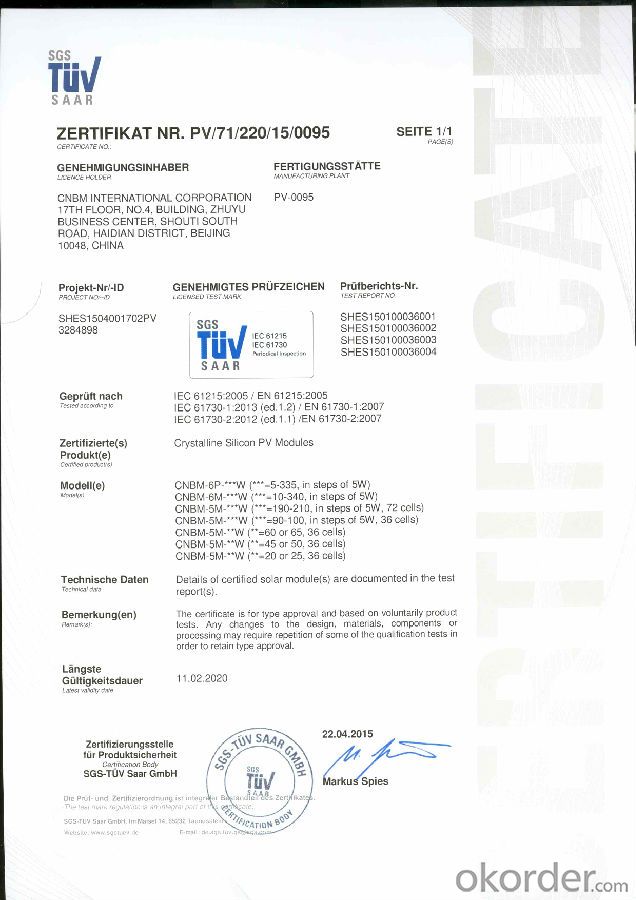
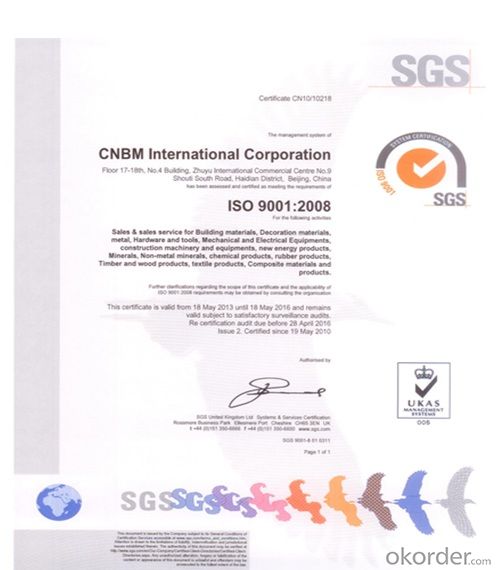

FAQ
We have organized several common questions for our clients,may help you sincerely:
①What price for each watt?
It depends on the quantity, delivery date and payment terms,
②What is your size for each module? Can you tell me the Parameter of your module?
We have different series of panels in different output, both c-Si and a-Si. Please take the specification sheet for your reference.
③Can you provide the peripheral products of the solar panels, such as the battery, controller, and inverter? If so, can you tell me how do they match each other?
Yes, we can, we have two companies for solar region, one is CNBM International, the other is CNBM engineering Co.
We can provide you not only the solar module but also the off grid solar system, we can also provide you service with on grid plant.
④What is your warranty system?
Our product performance guarantees for 25 years
• 12 years guarantee for workmanship
• Timeliness of delivery
• Quality Products certified (TÜV, UL, CE, ISO)
⑤How do you pack your products?
We have rich experience on how to pack the panels to make sure the safety on shipment when it arrives at the destination.
⑥ Can you do OEM for us?
Yes, we can.
⑦How long can we receive the product after purchase?
In the purchase of product within three working days, We will arrange the factory delivery as soon as possible. The pecific time of receiving is related to the state and position of customers.Commonly 7 to 10 working days can be served.
- Q: Hello, I have been trying to go green, I Have purchase somesolar panel they are about 45watts I been putting it against my window and getting ok power out of it enough for my lights and a couple of low watts gadget (cellphone, 2v light, portable dvd) for couple of hours.But its seem to drain the 2v faster then I can charge Am I getting the most power out of my panel?Or should I place it on the roof? I'm in Texas and it gets hot and sunny the sun beam my room windows pretty good during 4pm-6pm.
- It will generate MUCH more current if placed outside of the window. The best position is pointing directly south. Over the period of one day, you will get the most average sunlight pointing in that direction.
- Q: . The 2v battery will only be turning a small 2v motor that will be turning very slowly yet possibly or a long time. 2. -2 hours max per day it will be running3. I want it to be fully sufficient on solar power once the energy in the battery runs out. What specifications for my panel do you think I will need. However, i have limited space so the smaller the better as long as it can do the jobP.S: I don't know much about electricity and solar power so simple answers please :)
- batteries are rated with the help of the CCA, chilly cranking Amps the better the CCa the longer it is going to very last, don,t imagine you want a charge Controller as your consistently drawing juice from it, the picture voltaic panel will keep the bat at its height , then even as the solar is down , the pump will draw off the bat,
- Q: I have a 2 volt deep cylce Everstart battery with 845 cranking amps, and a Grape Solar GS-S-250-Fab5 250-Watt Monocrystalline Solar Panel . I use them to power a 48Flat screen TV, a Roku, my 65 watt consuming MacBook Pro, and a 65 watt Fan.I know from previous experience that just the battery, an inverter, and the fan, that the fan will blow for 0 hours straight.Should I really be concerned with a Charge Controller?
- Should I really be concerned with a Charge Controller? Yes. The main purpose of the charge controller is to protect the battery from over charging. Over charging reduces battery life. And spending extra money for a MPPT type controller will get more more useable power out of your solar panel. Would another battery of the same magnitude be helpful in preventing an accident? How much storage capacity does your current battery have (measured in kWH)? A ~$20 Kill-a-Watt meter would take a lot of uncertainty out of how much power you actually use. Even deep cycle batteries suffer reduced battery life from deep discharges. The battery sounds too small for the loads you describe so I would think you would want more. ---------------------------------------... After reading the other answer In a nutshell, with your small 2 volt starting battery, 24 volt panel and a mix of unknown loads, (which is correct), I thought I would elaborate. I had not considered the possibility that you bought a 24 volt panel for your 2 volt battery. Hooking the panel you bought directly to the current battery is a horrible idea. I you were lucky it would just cook the battery in a short period of time. You basically bought the wrong type of panel for a 2 volt system. I assume that there are no controllers on the the market for this situation. If that's the case, I don't know of any good way match the 24v panel to the 2 volt battery.
- Q: If a solar panel (using 36 3x6 solar cells) puts out 60 watts, how many panels would I need (for a house) if I use a max of 2300 kWh in a month? I checked my electric usage for the past 2 years and the kWh is usually lower but I wanted to use the most kWh used (2300) for my question. Thanks!
- The latter one has some strategies to consider for cutting your power consumption even more by timing your freezers and refrigerators..
- Q: How much space do solar panels require?
- The space required for solar panels depends on several factors such as the power output of the panels and the efficiency of the solar cells. On average, a typical solar panel requires around 10-20 square feet of space. However, it is important to note that solar panels can be mounted on rooftops, installed in large solar farms, or even integrated into building materials, allowing for flexibility in their placement and utilization of available space.
- Q: I want to plug my solar system battery bank into my transfer switch on my cabin when not using a generator. The transfer switch will handle 220 volt from my generator. How do I get a 220 volt inverter that runs 60 hz or do all of them run 50 hz.I see plenty of 20 volt 60 hz. I'm at the point of needing to order one and I'm not sure.
- Stand Alone solar panel inverters function to change direct current (DC) from a battery to Alternating Current (AC). Stand alone inverters, which range from around 00 watts to as much as 8000 watts, are used to power a vast variety of personal or small business projects. Lower watt stand-alone inverters are often used to power laptop computers, whereas high-watt stand-alone inverters could be used to help power an entire household. In order to calculate what class of inverter you need for use with your solar panel, you will first have to determine the maximum sum of all of the Alternating Current loads in your project (or home). How to calculate the wattage you need from your stand-alone solar panel inverter
- Q: Can solar panels be installed in a shaded area?
- Solar panels can be installed in shaded areas, but their efficiency and power output may be significantly reduced. Direct sunlight is necessary for optimal performance, so shaded areas may not provide the same energy generation as panels in direct sunlight.
- Q: I want to purchase some or one solar panel for my home. I don't know where to buy them from. I've loooked online and if i could buy them online that would be best, but if you knew of a website that has good prices than that would be great!Thanks
- I okorder Hope this helps.
- Q: I have a 2V .5W solar panel and I want to get a battery that can be charged by the solar panel that can then be used to power a 2V .5W fan. Ideally I want all the components to be connected and able to run without interaction. I have very little knowledge in regards to this field which is why I have come to yahoo answers. Any help would be greatly appreciated.
- There okorder / Why pay thousands of dollars for solar energy ($27,000 average cost) when you can build your own solar panel system for just a fraction of the retail cost. You can build a single solar panel or you can build an entire array of panels to power your whole house. Some people are saving 50% on their power bill, some people are reducing their bill to nothing. But what’s most impressive is that just by following these instructions some are even making the power company pay them!
- Q: I have in mind a small solar panel that could be plugged into a wall socket. Do I need a converter or some kind of interference between the two power sources so there aren't any unpleasant explosions? I don't know much about this sort of thing so please be nice.
- You can use a solar panel to heat water, and you can generate electricity, but you can't plug it into a wall socket. The most effective way to save on your energy bill is by heating water. Solar panels that produce electricity, don't store it. They produce it for that particular time, and if you're not there to use it, it's gone. Furthermore, the electricity isn't always regular, it may have peaks and shortages. The best way to tap into that, would be to sell the electricity you produce to the grid, and then buy it back when you use it.
Send your message to us
Campervan Solar Panels - 60W Polycrystalline Solar Module CNBM Series
- Loading Port:
- Shanghai
- Payment Terms:
- TT OR LC
- Min Order Qty:
- 25 pc
- Supply Capability:
- 20000 pc/month
OKorder Service Pledge
OKorder Financial Service
Similar products
Hot products
Hot Searches
Related keywords


